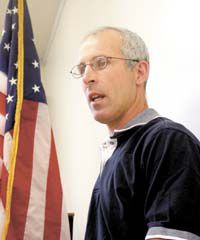City council considers raising vacant property fees to offset debt
| Jay Mashburn is consulting with East Carbon on the town’s water system rate structures. |
With bond payments overshadowing water fees the East Carbon City Council debated rate changes at its meeting Tuesday.
Jay Mashburn, a consultant with the Colorado-based Rural Community Assistance Corporation, presented the council with an overview of the city’s water user fees.
“A lot of this infrastructure needs a little tweaking of how your water rates are set,” he said.
Mashburn has been working with East Carbon to help make its water system more financially solvent.
He came with a thoroughly overhead projected presentation that showed a large discrepancy between what it costs to run the system versus what is collected from residents.
“East Carbon should be charging $34.13 for water which is a big gap from what people are paying today,” he said.
Residents pay $15.50 for the base amount of 6,000 gallons a month.
Mashburn explained that the city’s rates have not been keeping up with inflation and if they had the base rate would be $17.97.
However, former councilman Dave Maggio interjected that social security had not kept up with the inflation rate either and that many of city’s residents are on fixed incomes.
To which Councilwoman Darlene Kuhns added that 81 percent of East Carbon’s citizens were on either social security or welfare.
Mashburn commented that the city would actually even be in better shape if it tied its fees to social security rates, an idea that glanced off the council and faded quickly.
He then went forward with his presentation pointing out the income levels as determined in the 2000 census. In particular the number of residents living below the poverty level – 11 percent of adults and 18 percent of children.
“You have a significant number of children that be would effected by rate increases,” he said.
Playing to a tough crowd, Mashburn seemed to know that his facts and figures would be challenged almost immediately. He stood quietly as the audience and the council helped clarify the inherent problems with the stated levels.
“That census was eight years ago,” said Maggio. “It’s moldy and not necessarily up to date.”
Mayor Orlando LaFontaine further explained.
“The surveys were done by people who live here and some people weren’t exactly truthful,” he said.
Maggio clarifed a bit more.
“It’s kind of hard to tell the bank manager (indicating who was doing the census) that you only make $13,500 a year when you just asked for a new truck loan.”
Mashburn seemed to take serious note of the considerations before moving on to tell the council that the water rate system is also inequitable. He pointed to charts that show the more water someone uses the cheaper the cost to them.
“An older woman on a fixed income is paying the most for her glass of water,” he said.
The bottom line of Mashburn’s presentation was that East Carbon is not charging enough to pay for its system.
He pointed out that there are ongoing infrastructure costs associated with providing water and that the city owes $190,887 in bonds that even when restructured would be $139,078.
The reminder of the debts turned the conversation to not wanting to let things go so long that the state would step in.
The council members acknowledged that if the state were to take control that the city would have no control over how much rates would be raised.
While the council members seemed hard pressed to impose further financial burdens to residents, they did all seem amenable to a change in one rate.
Mashburn’s handouts thoroughly dissected the $4 a month rate for what are deemed vacant properties versus the basic rate for everyone else.
His materials identified 183 vacant properties receiving the highly reduced rate. He showed that the rate was losing East Carbon more $25,000 in revenues annually.
At first when the possibility of increasing the vacant rate to the basic rate was discussed, LaFontaine argued for a two-tiered approach. He suggested that residents be allowed to have the $4 rate but property owners from out of town not have the same opportunity.
In the end the council agreed that raising the rate across the board was the best.

